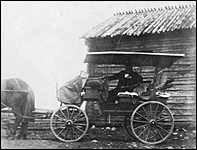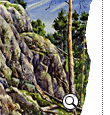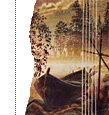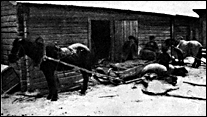 In Lönnrot's day, the early 1800s, Kainuu had few major roads. The road
from Iisalmi to Kajaani was completed in 1828 and it was the first state-built
road in Kainuu. A road from Kajaani to Sotkamo had been finished as early
as 1814, but, hardly worthy of the name, it was not used very much, as
travel by boat was a good deal faster. There was also a road of some description
to Oulu along the northern shore of Lake Oulujärvi, but this was not really
serviceable until repairs were completed in the mid 1800s.
In Lönnrot's day, the early 1800s, Kainuu had few major roads. The road
from Iisalmi to Kajaani was completed in 1828 and it was the first state-built
road in Kainuu. A road from Kajaani to Sotkamo had been finished as early
as 1814, but, hardly worthy of the name, it was not used very much, as
travel by boat was a good deal faster. There was also a road of some description
to Oulu along the northern shore of Lake Oulujärvi, but this was not really
serviceable until repairs were completed in the mid 1800s.
Roads were needed because of the system of inns, although the network at that time was modest indeed, being used only by the few servants of the Crown who happened to be about.
Boats were the most common means of getting around, the season permitting. Otherwise, people walked:
After walking about 13 km, we came to the shore of Lake Osmajärvi. The hopes that we had entertained of finding a boat there with which we could continue our journey were dashed. Accordingly, we started walking along the shore, leaving the lake on our left and, after 4 km, came to a strait connecting Osmajärvi to Kolvasjärvi. There we stopped and shouted as loudly as we could, "Boat, Boat!", but none appeared. Nor could our shouts be heard all the way to the village of Kolvajärvi, which was a good 3 km from the strait. But we had to get across the lake, as it simply too big to go around; even if we had tried, we would have come to a wide ditch as hard to cross as the strait. We had no option but to make a raft for ourselves in order to get across.
In winter, a sledge was the best way of getting around. This was the vehicle
Lönnrot recommended to those intending to collect poetry:
If one is interested in undertaking such a trip, I recommend he do it in winter. He will have an easier time getting all of his baggage where he is headed because he can have his own horse and sledge. In addition, at that time of year he is more likely to find people at home and less occupied with their work.
The many rapids in Kainuu slowed down travel
by boat and often interrupted trips completely. Lönnrot writes the
following about shooting rapids:
There are pilots for the most dangerous rapids, who live along them and are bound for a fee to steer a boat through and, if a mishap should occur, to compensate the traveller. One can tell from the expression on these helmsmen how important this undertaking is when he leans on his oar, which is fastened to the stern with a sturdy birch support. Where a stronger and faster turn is called for, the pilot takes on a helper above the rapids. The helper then puts his entire weight on the aft oar. A man's eyes and ears are never more carefully riveted on an object that the attention of the helmsman is on the rapids before him as he guides the boat through.
One cannot be off by even 10 cm from the intended route. Many of the peasants shoot these rapids themselves, but it is impossible for them to know every rock the way the real helmsmen do. But they have an amazingly well trained and sharp eye for noticing rocks - even those deep beneath the surface - at a distance. Where the uninitiated see nothing but the surface of the water, which does not look unusual in any respect, they can say at a considerable distance here a rock is and even how deep it is. With this skill they can even shoot rapids they have never been down before, provided the rapids are not overly difficult. But not everyone can acquire such skill.
Many have to use a special helmsman for years and never muster the courage to try the rapids themselves. Other, who do make such an attempt, often pay dearly for their foolhardiness... When one has made it safely and successfully, it is customary to have a drink. Some rapids have such a reputation that more than one drink is in order, and they say that they pay this tribute to the first rapids especially. They think that by showing this sign of respect to the first rapids, they pay tribute to the remaining ones, which the first has represented, because it is both the
first and the uppermost of them all. In fact, not long ago a respected and hard-working peasant had had so many drinks in honor of the rapids that his legs refused to hold up the rest of his body. To his great misfortune, the parish priest happened to come by and the peasant, according to custom, felt obliged to greet him with a handshake. When he found out from his friends when the priest was arriving, he said - with little regard to his condition: "Brothers, friends, hold me upright so I can shake hands with the master." Two of his companions propped him up, one on each side, long enough for him to pay his respects to the priest.



